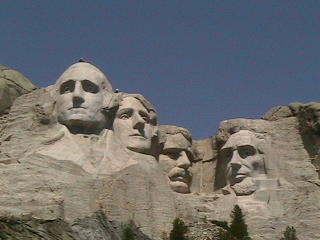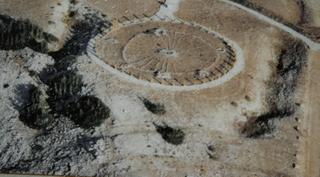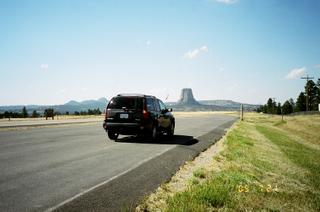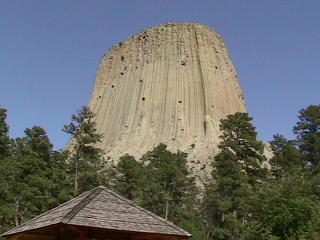 While the Image seen here, is one week into our trip back east to the prairies, this leg of the vacation is being shown for a particluar reason.
While the Image seen here, is one week into our trip back east to the prairies, this leg of the vacation is being shown for a particluar reason. HUman nature saids we like to embedded and concretize the greater philosophies into the images of history? Americanization would embue itself to the higher standards of which this society would develope itself. So with insight, a sculptor might embedded these into the images that we visited, to see here. Allow people to give nergy to such gatherings and become the blazoned typical image to reside now in the deeper functions of scoieties long lasting and timeless embodiement within that same consciousness.
BIGHorn Medicine Wheel

This place is called Big Horn Medicine Wheel, and is located near Sheridan Wyoming.
At a elevation of 9642 this is located on Medicine Mountain. This Medicine Wheel, was used by the Crow and Cree Indians and is remote and inaccessible most of the year.
While the walk is about a mile and half in, the trail takes you to vistas, and reasons why such a view woud have held the nature of sight beyond border from sights seen at lower elevations. At that Height, it was beautiful, and held me in wonder why such a jouney would have been endured by these cultures to participate in a ritual of harmony.
This is one aspect of the culture to which the idea of "liminocentric structures" are brought forward for inspection, and aside from the context with which I have spoken here in this blog. I wanted this relation to reveal the topological recognition of what wraps the brain and bodies's home much like the earth, that although it is physical as th ebody is the earth has certain qualties that we give the earth body, a layered recognition, much like the pearl, deepr levels of consciousness exist.
But there is another layer to the idea of what existed long before we had ever set our hands to work in these concretize forms, that the historical significance reminds us of a civilization that existed long before the scuptor saw fit to immortalize the subject in stone.
But before I continue with this explanation I wanted to move forward with the idea of this entry, so one gets this sense of the layered vision with which we assign humanities philosphies to concretization and heights, from which modern day visions are circumvented to our daily lives.
Devil's Tower

From a distance, as I looked at this object of consideration,I thought too, that such a distance could have been associated to the depth with which our consciousness sees fit to bring into the light of day, much as the story unfolds in Close Encounters of the Third Kind.
So who is that plants these idealizations in the hisory of mankind, that such mountains and stories of myth would challenge the mind to ascend the mountain landscape, to become in touch with the finer aspect of spirit, that so close and intouch we might have become with the true goals of what exists at these deeper levels of mind. That such universality would have pointed all to the aspect with which we encounter these deepr levels of unconsciousness that you or I have given, in meaning?
Where the greater context of people gather on a scupltured mountain, or high mountain place that a INdian culture would gather, or where the society would see the layered source of true metal, of mountain stone revealled, in President Heads, or as Devil's tower?
The struggle is for recognition, and verbalization, artistically inclined, that such a struggle would bring identification to a certain reality and life's fulfillment of a plannned unfoldment in one's life's work.
 I am not sure if any remember this image when it was first introduced for the general public in a movie known as, Close Encounters of the Third Kind." Where Richard Dreyfuss in his struggle to identify this deeper conscious recognition implanted in the brains of the public, for a meeting ground of contact.
I am not sure if any remember this image when it was first introduced for the general public in a movie known as, Close Encounters of the Third Kind." Where Richard Dreyfuss in his struggle to identify this deeper conscious recognition implanted in the brains of the public, for a meeting ground of contact.The nearly vertical monolith known as Devils Tower rises 1,267 feet above the meandering Belle Fourche River. Once hidden below the earth's surface, erosion has stripped away the softer rock layers revealing Devils Tower.
Known by several northern plains tribes as Bears Lodge, it is a sacred site of worship for many American Indians. The rolling hills of this 1,347 acre park are covered with pine forests, deciduous woodlands, and prairie grasslands. Deer, prairie dogs, and other wildlife are abundant.
Proclaimed September 24, 1906 as the nation's first national monument by President Theodore Roosevelt.
So it seems such a idea of the first contact of the extraterristial kind should have brought the publics to consensus in this planted image of gathering. What value then of such a natural consequence would lead anyone to write this image into a movie and draw from the myth that surrounds it's very formative and geophysical relevance to other worldly ideas?
A electrical beacon for other civilizations? The universality of a life living would be in greater context then the one life we choose to live now? The greater context would say, that Like Ben Franklin, the cloak with which we wear, can be taken off and put on. But in the deeper context of this outer covering, the truth still exists and is retained as a thread, through all our choosen existances.
So we are not so divide in this culture or that one that we might not have expeirnced the model of wholeness through which each life is represented as a point onthis circle of time, that such wholeness would say that the inner/outer compulsion for expression would be out there int helayered vsions of relaity yet they are tied deeply to the home in which we live now. The Earth with which we reside now?
